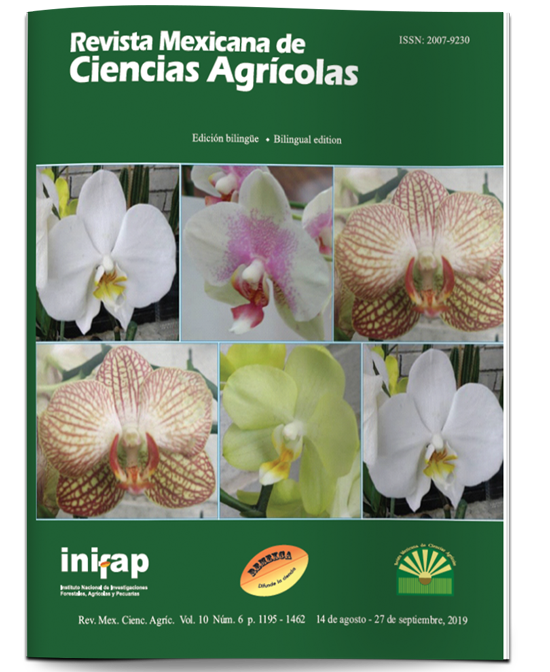Adaptation of black bean genotypes to different environments of Veracruz and Chiapas
DOI:
https://doi.org/10.29312/remexca.v10i6.1658Keywords:
Phaseolus vulgaris L., genotype-environment, interaction, improved linesAbstract
In the present investigation, the main additive effects and multiplicative interaction (AMMI) model was used to determine the yield and stability of 12 lines and two varieties of opaque black beans, evaluated during 2016 and 2017, in 10 environments of Veracruz and Chiapas, Mexico. The trial was established in experimental design random blocks with three repetitions and plots of three rows of 5 m in length. The grain yield was quantified, which was analyzed individually by environment and combined (environments-genotypes) of the 10 test environments, stability parameters were also estimated with the AMMI model. The Experimental Field Ixtacuaco and Rincon Grande, Veracruz, in autumn-winter 2016-2017 under residual humidity, were the environments that combined low interaction and high productivity, making them ideal for identifying genotypes with high and stable performance. Venustiano Carranza, Chiapas, in autumn-winter of 2016-2017, El Rubi, Veracrus, in winter-spring of 2017 with irrigation and New Mexico, Chiapas, in summer of 2016, in whitewashed acid soil, were the environments that more interacted with genotypes. The Jamapa Plus/XRAV-187-3-1-8 line showed the least interaction with the environment (much higher than that shown by the Negro Comapa and Negro Grijalva varieties), as well as high average yield (1 437.3 kg ha-1), while Jamapa Plus/XRAV-187-3-1-2, was the most profitable line (1 504.3 kg ha-1), but its adaptation was specific, mainly in environments with edaphic acid stress in the center from Chiapas and by terminal drought in the center of Veracruz.
Downloads
Downloads
Published
How to Cite
Issue
Section
License
The authors who publish in Revista Mexicana de Ciencias Agrícolas accept the following conditions:
In accordance with copyright laws, Revista Mexicana de Ciencias Agrícolas recognizes and respects the authors’ moral right and ownership of property rights which will be transferred to the journal for dissemination in open access. Invariably, all the authors have to sign a letter of transfer of property rights and of originality of the article to Instituto Nacional de Investigaciones Forestales, Agrícolas y Pecuarias (INIFAP) [National Institute of Forestry, Agricultural and Livestock Research]. The author(s) must pay a fee for the reception of articles before proceeding to editorial review.
All the texts published by Revista Mexicana de Ciencias Agrícolas —with no exception— are distributed under a Creative Commons License Attribution-NonCommercial 4.0 International (CC BY-NC 4.0), which allows third parties to use the publication as long as the work’s authorship and its first publication in this journal are mentioned.
The author(s) can enter into independent and additional contractual agreements for the nonexclusive distribution of the version of the article published in Revista Mexicana de Ciencias Agrícolas (for example include it into an institutional repository or publish it in a book) as long as it is clearly and explicitly indicated that the work was published for the first time in Revista Mexicana de Ciencias Agrícolas.
For all the above, the authors shall send the Letter-transfer of Property Rights for the first publication duly filled in and signed by the author(s). This form must be sent as a PDF file to: revista_atm@yahoo.com.mx; cienciasagricola@inifap.gob.mx; remexca2017@gmail.
This work is licensed under a Creative Commons Attribution-Noncommercial 4.0 International license.



